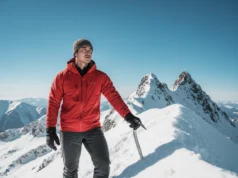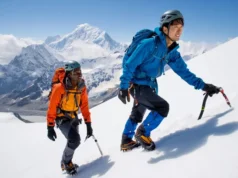In this article
For many hikers ready for the next adventure, the question of what is scrambling hiking often comes up. Scrambling is the thrilling discipline that begins where well-maintained trails end, a true in-between-adventure. This unique outdoor activity bridges the gap between ambitious hiking and technical climbing, requiring the use of your hands for upward progress and balance. Unlike a typical hiking trail, where you might occasionally touch a rock for stability, a scramble involves the necessary and consistent use of your hands. Yet, it differs from roped climbing because, especially in its lower classes, it doesn’t typically require a rope for safety. These alpine scrambling basics are as much a mental discipline as a physical one, where your personal judgment becomes your primary safety system on challenging terrain.
Decoding the Terrain: The Yosemite Decimal System (YDS)
To safely navigate the world of scrambling, you must first learn its language. In North America, that language is the Yosemite Decimal System (YDS), which classifies terrain difficulty. This section breaks down the specific classes relevant to this pursuit—2, 3, and 4—so any scrambler can understand precisely what to expect when they venture off the beaten path and match the climbing route to their skill level.
Understanding YDS Principles
The YDS was originally developed by the Sierra Club in the 1930s, and these hiking classes were later refined to create a standardized scale from Class 1 (simple trail walking) to Class 5 (technical rock climbing). Understanding this framework and its scrambling grades is essential before you step into off-trail territory. One of its core tenets is the “Crux Dictates the Grade” principle. This means a route’s official classification is determined by its single most difficult section. A long, otherwise easy YDS class 2 route with one mandatory Class 4 move is rated as a Class 4 route, forcing you to prepare your gear and mindset for the hardest part of the day.
Ratings are also inherently subjective, assigned by humans and influenced by factors like height, experience, or climbing style. What an experienced climber calls an “easy Class 3” might feel much harder for a less experienced individual. For this reason, you should always treat guidebook ratings as a valuable guide, not an absolute truth, when planning on gradually increasing hike difficulty.
Class 2: The Gateway Scramble
Class 2 is the entry point to scrambling, often involving off-trail travel across uneven, rocky terrain like boulder fields or talus slopes. Here, you will use your hands occasionally, but mostly for balance rather than for pulling your body upward. This class marks a clear transition from merely walking on a path to actively navigating the landscape itself.
While the general path on this easy terrain is often obvious, some basic route-finding may be needed. A fall is considered unlikely, but a slip on the slope could certainly result in minor injuries like scrapes or a sprain. No specialized climbing gear is necessary beyond what a hiker would carry on a strenuous day hike, though some still prefer trekking poles on the approaches. Good examples include the stable talus hopping on the standard route up Mount Agassiz in California’s Sierra Nevada or the summit block of Mount Si in Washington, which gives a great feel for what “occasional hand use” entails.
Class 3: The Heart of Scrambling
Class 3 scrambling is where true, sustained effort begins, demanding continuous use of your hands for upward movement. The terrain steepness increases and is more vertical, but handholds and footholds are typically large and plentiful, making progress feel straightforward. It requires more physical engagement and confidence than Class 2.
Exposure—the sense of airiness below you—becomes a significant and defining factor on this steep terrain. Although the climbing moves might be simple, a fall could lead to serious injury or even prove fatal. Consequently, navigation skills become much more critical, as wandering off the easiest line can quickly lead to much more dangerous terrain like Class 4 or 5. A helmet is highly recommended because of the increased risk from falls and potential rockfall from above. While experienced scramblers often don’t use a rope, one is frequently carried for parties with less experienced members as a “confidence line” to safeguard a tricky move, not to protect a leader fall.
Class 4: Where Scrambling Meets Climbing
Class 4 is a serious step up, where hard scrambling occupies a gray area between difficult scrambling and easy technical rock climbs. It involves difficult and exposed scrambling on very steep terrain with considerable and continuous exposure, though it still tends to have good, abundant holds. This technical terrain demands a high level of commitment and sharp risk assessment.
Class 4 is unequivocally a “no-fall zone,” where an un-roped fall would almost certainly be fatal. The distinction between a hard Class 4 and an easy Class 5 route is often a topic of debate among climbers, but a key indicator is that they will almost always face into the rock when performing scramble descents. For this reason, a rope is highly advisable and used by most parties. Protection is usually managed with simple belays anchored to natural features like rock horns, and a helmet is considered non-negotiable.
Essential Scrambling Skills and Techniques
Moving from theory to practice, mastering fundamental outdoor skills is what separates a safe scrambler from a reckless one. This involves understanding core movement principles, perfecting your footwork with various techniques, and developing the critical abilities of down-climbing and route-finding before you need them on the mountain.
The Three Laws of Movement
The golden rule of scrambling is to always maintain three points of contact with the rock (two feet and one hand, or two hands and one foot). This method creates a stable, tripod-like base and ensures your body remains in a state of static balance whereas climbers might focus more on strength. A common beginner mistake is hugging the rock out of fear, which actually pushes your feet from their holds and strains your arms. Instead, focus on keeping your center of gravity low and over your feet to maximize balance and friction.
Finally, you must get into the critical habit of testing every handhold and foothold before committing your full body weight. Rock can be deceptively unstable. Check holds by tapping them to listen for a hollow sound or by gradually weighting them to see if they shift. This simple check must become an automatic reflex to prevent a fall caused by a breaking hold.
Mastering Your Footwork
In scrambling, your legs should be the primary engine for your ascent, with your arms used more for balance and stability. This approach conserves upper-body strength and makes precise footwork the cornerstone of good technique. Core rock climbing techniques like edging, smearing, and bridging are directly applicable here. “Edging” involves using the stiff edge of the boot on small ledges, while “smearing” relies on maximizing your boot’s rubber friction on smooth, low-angle slabby terrain. “Bridging” uses opposing pressure to ascend corners or chimneys.
We also teach the concept of “quiet feet,” which encourages placing each foot with precision and deliberation instead of scraping at the rock. This technique not only improves stability and saves energy but also reduces the risk of dislodging loose rock onto your partners below.
Advanced Skills: Down-Climbing and Route-Finding
Descending a scramble is often more difficult and psychologically intimidating than going up. Holds are harder to see, and gravity becomes a more potent force. The ability to down-climb safely is therefore a non-negotiable skill for any unroped scramble. On steeper sections, it is essential to turn and face into the rock, descending as if you were on a ladder. Always remember the critical safety adage: “Don’t climb up what you can’t climb down.” This foresight helps prevent you from getting stuck in a dangerous position.
If maintaining three points of contact is the most important physical skill, then Route-finding is the most critical mental one. Unlike technical climbing, where the goal can be difficulty, a scrambler’s goal is to find the path of least resistance. You do this by looking for signs of passage like worn rock and natural lines of weakness, such as ramps and ledges, constantly observing the terrain on macro, medium, and micro scales.
Gearing Up for Scrambling: A Class-by-Class Toolkit
Having the right gear in your pack is fundamental to safety and confidence in the mountains. This section provides a practical guide to the equipment you’ll need, covering universal essentials like footwear and then detailing class-specific recommendations as the varied terrain becomes more serious.
The Footwear Foundation
No piece of gear has a more direct impact on your security than your footwear. For many Class 2 and easier Class 3 scrambles, sturdy hiking boots are adequate. As you progress, however, specialized footwear becomes a significant advantage. Approach shoes are a hybrid that combines the comfort of a hiker with the high-friction “sticky” rubber sole of a climbing shoe. This enhanced grip provides a tangible performance and confidence boost on technical rock.
A logical progression is to start with your trusted hiking boots on Class 2 terrain. As you advance to more sustained and technical Class 3 and 4 routes, investing in a quality pair of approach shoes is a highly recommended step that will greatly enhance your performance and safety.
Class 3 Gear: Adding Protection
Class 3 marks the point where specialized safety gear becomes highly recommended due to increased hazards. The most important addition is a climbing helmet, which protects you not only from a fall but also from the significant objective hazard of rockfall. Many parties also carry a short, lightweight “confidence rope” (around 30 meters). This is not used for traditional lead climbing but to provide a simple belay or hand-line on a short, intimidating step or one of the difficult segments.
While not essential, many scramblers also prefer thin, grippy gloves. These protect hands from scrapes on rough rock without sacrificing too much of the tactile feel needed for judging holds.
Class 4 Gear: The “Light Rack”
Gear for Class 4 terrain is effectively a minimal climbing kit, or “light rack,” because a fall here has severe consequences. The goal is to carry just enough equipment to protect short, crux sections, not to pitch out entire routes. A typical light rack includes a thin rope (30-35 meters), a minimalist harness, several long slings with locking carabiners, and a small set of nuts or cams.
A lightweight belay/rappel device is essential. You must be proficient not only in belaying a partner but also in setting up and executing a rappel. The ability to retreat safely from a difficult section via rappel is a fundamental safety skill at this level of mountaineering.
The Scrambler’s Mindset: Risk, Responsibility, and Leaving No Trace
Beyond skills and gear, scrambling demands a particular mindset. Success and safety hinge on your approach to risk management, your situational awareness, and your commitment to traveling responsibly through fragile, off-trail environments. This means managing hazards and embracing the ethics of your impact during your outdoor adventure.
Objective vs. Subjective Hazards
Objective hazards are dangers inherent to the mountain environment that are largely outside your control. These include things like spontaneous rockfalls or rock slides, sudden weather changes, and unstable snow conditions. While they can’t be eliminated, their risks can be mitigated through careful planning, like checking forecasts, planning for an alpine start to avoid afternoon storms, and avoiding terrain traps like a steep ravine at high-risk times.
Subjective hazards are dangers introduced by you or your party—factors over which you have the most control. These include poor judgment, inadequate fitness, route-finding errors, or succumbing to “summit fever.” Mountain training is primarily focused on minimizing these self-induced risks. For rockfall, a primary hazard, always wear a helmet, manage your position relative to others, move with “quiet feet,” and immediately yell “ROCK! ROCK! ROCK!” if you dislodge anything.
The “Leave No Trace” Alpine Ethic
Scrambling provides access to incredibly wild and fragile environments, from Rocky Mountain peaks to remote desert canyons, and with that privilege comes a profound responsibility. For off-trail travelers, a deep commitment to the Leave No Trace (LNT) principles is an ethical imperative. The most critical of these principles is to Travel and Camp on Durable Surfaces. This means staying on rock, scree, or snow whenever possible to protect exceptionally fragile alpine vegetation.
Proper waste disposal is also magnified at altitude. This includes packing out all trash and food scraps, even “biodegradable” items like apple cores that decompose extremely slowly in the cold. For human waste, the gold standard is to use a commercial waste-disposal bag system (a “WAG bag”) and pack it out, as digging a proper cathole is often impossible in the thin, rocky soil.
Conclusion: Your Path to the Peaks
Scrambling is a hugely rewarding progression for experienced hikers, but it demands a deliberate approach built on skill, fitness, and judgment for successful scrambling experiences. The most important takeaway is to start slow. Begin with well-documented Class 2 hikes to build your off-trail experience and master movement on rock in low-consequence settings before attempting Class 3 terrain. As you progress, seek mentorship from experienced partners, consider a professional course for instruction, and use climbing gyms to practice movement. By understanding the risks, mastering the skills, and embracing the responsibility, you can safely unlock a thrilling new world of mountain adventure. Happy scrambling!
Frequently Asked Questions about Scrambling
What is the main difference between Class 3 and Class 4 scrambling? +
Do I need special shoes for scrambling? +
Is scrambling the same as free soloing? +
What is the single most important skill for a new scrambler to learn? +
We are a participant in the Amazon Services LLC Associates Program, an affiliate advertising program designed to provide a means for sites to earn advertising fees by advertising and linking to Amazon.com. As an Amazon Associate I earn from qualifying purchases. We also participate in other affiliate programs. The information provided on this website is provided for entertainment purposes only. We make no representations or warranties of any kind, expressed or implied, about the completeness, accuracy, adequacy, legality, usefulness, reliability, suitability, or availability of the information, or about anything else. Any reliance you place on the information is therefore strictly at your own risk. Additional terms are found in the terms of service.





